Ahead of international World Water Day observations on Thursday and Saturday, ���۴�ýlooks at perceived water quality around the world and sanitation conditions in sub-Saharan Africa. This article, the first in a two-part series, examines water quality perceptions.
WASHINGTON, D.C. -- Majorities in most of the 145 countries ���۴�ýsurveyed in the past several years say they are satisfied with the water quality in their communities. But many of those who live in sub-Saharan Africa -- where the Millennium Development Goal (MDG) target for safe drinking water will likely not be reached -- say otherwise.
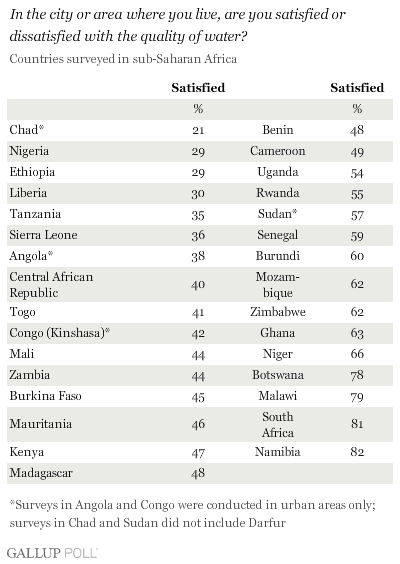
While most of the world appears to be on track to reach the MDG target of halving the proportion of people without access to safe drinking water by 2015, sub-Saharan Africa is lagging far behind because of slow progress, low coverage, and significant disparities between urban and rural areas.
This situation may have some influence on residents' perceptions of water quality in their communities. Overall, respondents in the sub-Saharan region are the least likely of any region ���۴�ýstudied to express satisfaction with the water quality in their communities; the regional median satisfaction is 48%. In sub-regions, median satisfaction ranges from 45% in West Africa to 62% in southern Africa.
Middle East/North Africa
In the Middle East and North Africa -- one of the most water-scarce regions of the world -- the regional median percentage of satisfaction with water quality is 55%. Within the region, satisfaction ranges from a low of 35% in Lebanon (measured just after the 2006 Israeli-Hezbollah conflict) to 79% in the United Arab Emirates.
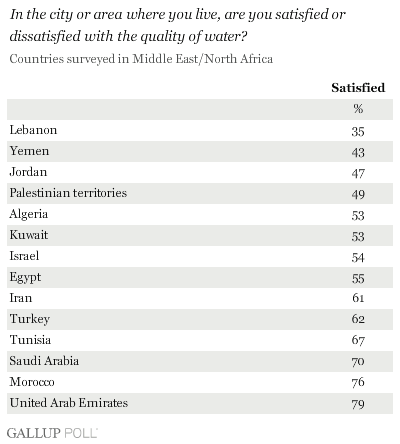
Water management problems, according to a World Bank report on water scarcity in the region, are already apparent and likely to get worse as demand increases: aquifers are over-pumped, water quality is deteriorating, and water supply and irrigation services are often rationed.
Commonwealth of Independent States
Water quality issues are familiar to many residents in the Commonwealth of Independent States (CIS), where the regional median satisfaction with water quality is 58%. In Moldova, for example, the UN Development Program states that about 80% of the water treatment plants do not work and untreated wastewater is discharged into water sources. And in Kazakhstan, the shrinking, polluted Aral Sea threatens water security in the area.
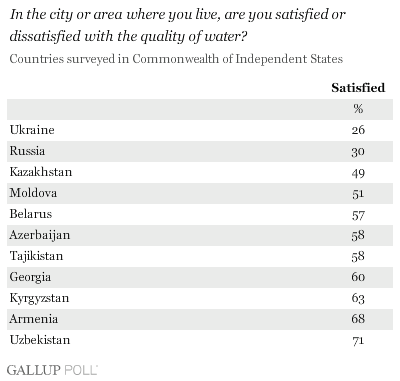
Residents of two countries in this region -- Russia and Ukraine -- express some of the lowest satisfaction levels ���۴�ýmeasured around the globe: only 30% of Russians and 26% of Ukrainians say they are satisfied with the water quality in their communities.
Asia
Of the world's 1.1 billion people that the United Nations estimates lack access to safe drinking water, the majority live in East Asia and South Asia. But unlike their sub-Saharan African counterparts, these regions are on track to reach the MDG target for access to drinking water. The regional median satisfaction with water quality across Asia is 68%.
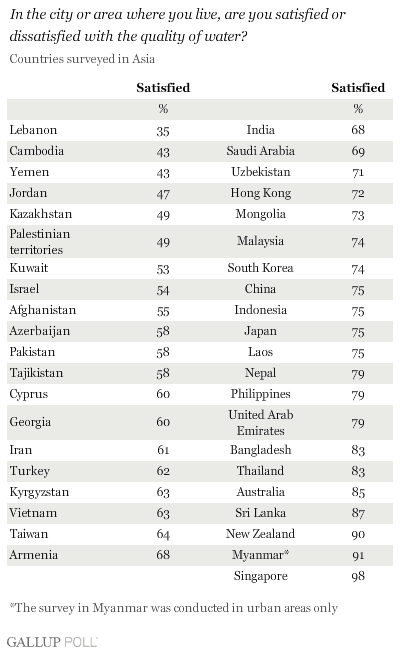
The medians for the sub-regions of East Asia (74%), Southeast Asia (75%), South Asia (74%), and developed countries and territories of Asia (75%) are slightly higher than the broader regional median.
Latin America and the Caribbean
In the water-rich Latin America and the Caribbean region, regional median satisfaction with the water quality is relatively high at 72%. But water access in this region is extremely unequal and its vast resources are prone to exploitation and contamination.

These inequalities are apparent in the varying levels of satisfaction throughout countries in the region and at the sub-region level. In South America and Mexico, the median satisfaction is 78%, while the median is 59% for the Caribbean and 70% for Central America.
Central, Southern, and Southeast Europe
Water quality perceptions among residents in Southeast Europe are more in accord with those in the CIS region than they are with others in Europe, which is interesting given several countries' overtures to join the EU, but not surprising because they experience some of the same water issues. The regional median satisfaction for Southeast Europe is 61%, compared with the 58% median for CIS.
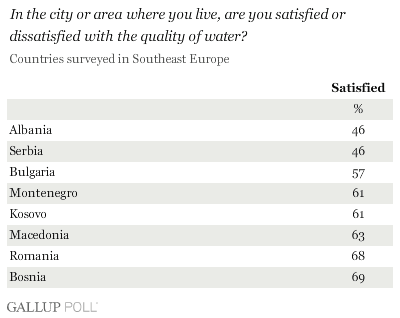
The regional median satisfaction for Central Europe is 78%, while median for southern Europe is 70%.
Western Europe, the United States, Canada, and Northern Europe
Of all the populations surveyed, satisfaction with water quality is highest in the region that includes Western Europe, Canada and the United States, and in the Northern Europe region. The regional median satisfaction for Western Europe, the United States, and Canada is 87%, and the regional median for Northern Europe is an even higher 94%.
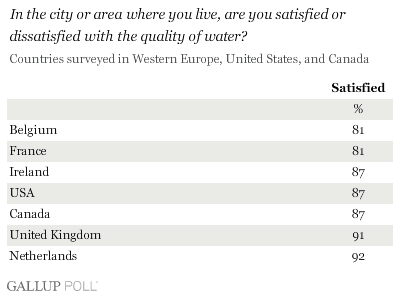
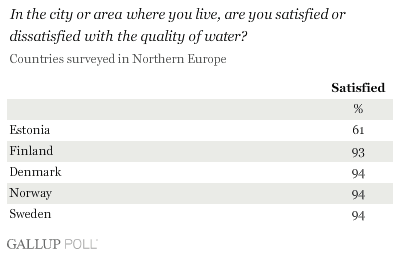
Access to safe, clean drinking water is for the most part not an issue for people in these countries. Residents enjoy a relatively high standard of living and their governments' water quality standards are among the strictest in the world. Nonetheless, the recent AP investigation in the United States that revealed traces of pharmaceuticals in the drinking water supplies of more than 41 million Americans underscore the need for continuing improvement and advancement in this arena.
Survey Methods
Results are based on telephone and face-to-face interviews conducted throughout 2006 and 2007. Randomly selected sample sizes typically number 1,000 residents, aged 15 and older, in the 145 countries polled. In Angola and Congo, surveys were conducted in urban areas. Surveys in Chad and Sudan did not include Darfur. For results based on samples of this size, one can say with 95% confidence that the maximum error attributable to sampling and other random effects is ±3 percentage points. The margin of error in countries in sub-Saharan Africa is ±5. In addition to sampling error, question wording and practical difficulties in conducting surveys can introduce error or bias into the findings of public opinion polls.
